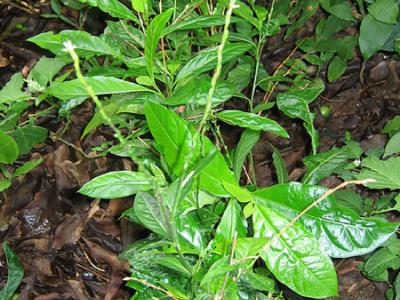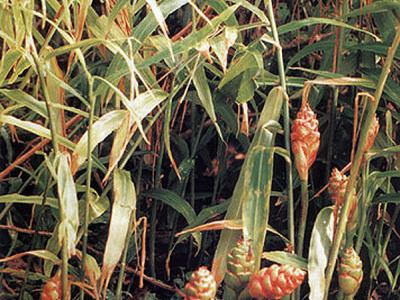(In territories with significant traditional TRAMIL use)
Dominican Republic:
- anamú
Colombia:
- anamú
Panama:
- anamú
Guatemala:
- apacín
Haiti:
- ave
Honduras:
- ipacina
Dominica:
- koujourouk
leaf and stem, decoction, orally8
According to published and other information:
Use for digestive conditions (stomach pain, bad or slow digestion and intestinal gas) toothache, muscle pain, skin diseases, rheumatism and common cold is classified as REC, based on the significant traditional use documented in the TRAMIL surveys and toxicity studies.
Should there be a notable worsening of the patient’s condition, or should stomach pain persist for more than 3 days, seek medical attention.
Use for headache, flatulence, flu and nasal congestion (sinusitis) is classified as REC, based on the significant traditional use (OMS/WHO)11 documented in the TRAMIL surveys.
For topical application, strict hygiene measures should be observed in order to avoid contamination or additional infection.
Considering the risks of documented interactions with insulin or oral hypoglycemiants, the decoction of the leaf and stem should not be ingested by patients taking or using these medicines due to the risk of magnifying their effects.
The root and the stem can cause reactions of hypersensitivity.
Not for use during lactation or by children under 12 years old.
Not for use during pregnancy because it may be abortifacient.
For digestive conditions and common cold:
Prepare a decoction with 30 grams (3 spoonfuls) of ground leaf in 1 liter of water (4 cups). Boil for at least 10 minutes in a covered pot. Filter, allow to cool and drink 2-3 cups a day37.
For rheumatism:
Prepare a decoction with 30 grams (3 spoonfuls) of ground leaf and root in 1 liter of water (4 cups) for at least 10 minutes in a covered pot. Filter, leave to cool down and drink 2-3 cups a day37.
For nasal congestion (sinusitis):
Prepare a fine powder of the root and stem from dried and sieved material, inhale 0.2 to 0.5 grams through each nostril, 2 times a day38.
For headache, toothache, muscle pain, flatulence, flu and skin diseases:
There is no available information establishing a means of preparation and dosage other than that referred to by traditional use.
Any medicinal preparation must be preserved cold and used within the 24 hours.
1 GIRON L, 1988
Encuesta TRAMIL (Costa atlántica). Centro Mesoamericano de Tecnología CEMAT, Guatemala, Guatemala.
2 SOLIS P, CORREA M, GUPTA M, 1995
Encuesta TRAMIL (Comunidades afro-caribeñas). Centro de Investigaciones Farmacognósticas de la Flora Panameña CIFLORPAN, Facultad de Farmacia, Universidad de Panamá, Panamá, Panamá.
3 CHARLES C, 1988
TRAMIL survey. Movement for Cultural Awareness MCA, Roseau, Dominica.
4 GOMEZ H, GAITAN R, DIAZ F, 2003
Encuesta TRAMIL (Norte del departamento de Bolívar). Grupo de Productos Naturales, Facultad de Ciencias Químicas y Farmacéuticas. Universidad de Cartagena, Cartagena de Indias, Colombia.
5 CASTILLO D, RODRIGUEZ S, DE LOS SANTOS C, BELEN A, 2003
Encuesta TRAMIL (región Este). Dep. de Botánica, Jardín Botánico Nacional, Santo Domingo, Rep. Dominicana.
6 GERMOSEN-ROBINEAU L, GERONIMO M, AMPARO C, 1984
Encuesta TRAMIL. enda-caribe, Santo Domingo, Rep. Dominicana.
7 CASTILLO D, RODRIGUEZ S, DE LOS SANTOS C, BELEN A, 2003
Encuesta TRAMIL (Zambrana, Cotuí). Dep. de Botánica, Jardin Botánico Nacional, Santo Domingo, Rep. Dominicana.
8 LEMUS Z, GARCÍA M, BATISTA A, DE LA GUARDIA O, CASTILLO A, 2004
La tableta de anamú: un medicamento herbario inmunoestimulante. MEDISAN 8(3), 57-64.
9 WENIGER B, SAVARY H, DAGUIHL R, 1984
Tri phytochimique de plantes de la liste TRAMIL. Laboratoire de chimie des substances naturelles, Faculté de Médecine et de Pharmacie, Université d'Etat d'Haïti, Port au Prince, Haïti.
10 HEGNAUER R, 1973
Chemotaxonomy der Pflanzen. Basel, Schweiz: Birkhauser Verlag. 6:882.
11 SEGELMAN F, SEGELMAN A, 1975
Constituents of Petiveria alliacea. Lloydia 38(6):537.
12 DE SOUSA JR, DEMUNER AJ, PINHEIRO JA, BREITMAIER E, CASSELS BK, 1990
Dibenzyl trisulphide and trans-N-methyl-4-methoxyproline from Petiveria alliacea. Phytochemistry 29(11):3653-3655.
13 BOUCOURT E, MARTINEZ M J, MOREJON Z, 2010
Evaluación de la actividad antimicrobiana del extracto acuoso de la raíz fresca de Petiveria alliacea L. Informe TRAMIL. Laboratorio Central de Farmacología, Facultad de Ciencias Médicas “Dr. Salvador Allende”, La Habana, Cuba.
14 FURONES JA, MORON F, PINEDO Z, 1996
Ausencia de la acción analgésica de la Petiveria alliacea (anamu) en ratones. Rev Cubana Planta Med 1(1):16-18.
15 DEL CARMEN RIVAS C, JIMENEZ M, AYALA L, CARILLO C, CABRERA Y, 1988
Actividad anti-inflamatoria y analgésica de Petiveria alliaceae. Informe TRAMIL. Centro de Investigación y Desarrollo de Medicamentos (CIDEM), La Habana, Cuba.
16 FURONES JA, MORON F, PINEDO Z, 1996
Ausencia de actividad antiinflamatoria del extracto acuoso liofilizado de Petiveria alliacea (anamú) en ratas. Informe TRAMIL. Rev Cubana Planta Med 1(2):34-37.
17 MARTINEZ MJ, BETANCOURT J, LOPEZ M, MOREJON Z, FUENTES V, MORON F, PINEDO Z, BOUCOURT E, 2001
Actividad antimicrobiana y sobre varias preparaciones de músculo liso, in vitro, de la decocción liofilizada de hoja de Petiveria alliacea. Informe TRAMIL. Laboratorio Central de Farmacología, Facultad de Ciencias Médicas “Dr. Salvador Allende”, La Habana, Cuba.
18 GARCIA GM, COMO MT, GONZALEZ CS, PAZOS L, 1995
Velocidad del tránsito intestinal en ratones, del extracto acuoso de hoja fresca de Petiveria alliacea. Informe TRAMIL. Laboratorio de Ensayos Biológicos LEBi, Escuela de Medicina, Universidad de Costa Rica, San Pedro, Costa Rica.
19 ECHEVARRIA A, TORRES D, 2001
Efecto de un extracto de Petiveria alliacea Lin sobre el crecimiento de Giardia lamblia in vitro. Rev Cubana Med Mil 30(3):161-165.
20 CACERES A, GIRON LM, ALVARADO SR, TORRES MF, 1987
Screening of antimicrobial activity of plants popularly used in Guatemala for the treatment of dermatomucosal diseases. J of Ethnopharm 20(3):223-237.
21 CACERES A, LOPEZ BR, GIRON MA, LOGEMANN H, 1991
Plants used in Guatemala for the treatment of dermatophytic infections. 1. Screening for the antimicotic activity of 44 plant extracts. J of Ethnopharm 31(3):263-276.
22 RUFFA MJ, PERUSINA M, ALFONSO V, WAGNER ML, SURIANO M, VICENTE C, CAMPOS R, CAVALLARO L, 2002
Antiviral activity of Petiveria alliacea against the bovine viral diarrhea virus. Chemotherapy 48(3):144-147.
23 CACERES A, JAUREGUI E, HERRERA D, LOGEMANN H, 1991
Plants used in Guatemala for the treatment of dermatomucosal infections. 1: Screening of 38 plant extracts for anticandidal activity. J of Ethnopharm 33(3):277-283.
24 GERMANO DH, CALDEIRA TT, MAZELLA AA, SERTIE JA, BACCHI EM, 1993
Topical anti-inflammatory activity and toxicity of Petiveria alliacea. Fitoterapia 64(5):459-467.
25 ANDERSSON DUNSTAN C, NOREEN Y, SERRANO G, COX PA, PERERA P, BOHLIN L, 1997
Evaluation of some Samoan and Peruvian medicinal plants by prostaglandin biosynthesis and rat ear oedema assays. J of Ethnopharmacol 57(1):35-56.
26 LIMA TCM, MORATO GS, TAKAHASHI RN, 1991
Evaluation of antinociceptive effect of Petiveria alliacea (guiné) in animals. Mem Inst Oswaldo Cruz 86(suppl.2):153-158.
27 FERRAZ MB, PEREIRA RB, IWATA NM, ATRA E, 1991
Tipi. A popular analgesic tea. A double blind cross-over trial in osteoarthritis. Clin Exp Rheumatol 9(2):205-206.
28 GARCIA GM, COTO MT, GONZALEZ CS, PAZOS L, 1996
Toxicidad sub-crónica en ratones, del extracto acuoso de hojas frescas de Petiveria alliacea. Informe TRAMIL. Laboratorio de Ensayos Biológicos LEBi, Universidad de Costa Rica, San Pedro, Costa Rica.
29 GUERRA MJ, BETANCOURT J, LOPEZ M, MOREJON Z, BOUCOURT E, FUENTES V, MORON F, 2001
Toxicidad aguda (DL50) oral de la decocción de hojas jóvenes frescas de Petiveria alliacea L. Informe TRAMIL. Laboratorio Central de Farmacología, Facultad de Ciencias Médicas “Dr. Salvador Allende”, La Habana, Cuba.
30 GUERRA MJ, BETANCOURT J, LOPEZ M, MOREJON Z, BOUCOURT E, FUENTES V, 2001
Toxicidad aguda (DL50) intraperitoneal de la decocción liofilizada de hojas frescas de Petiveria alliacea L. Informe TRAMIL. Laboratorio Central de Farmacología, Facultad de Ciencias Médicas “Dr. Salvador Allende”, La Habana, Cuba.
31 GUERRA MJ, BETANCOURT J, LOPEZ M, MOREJON Z, BOUCOURT E, FUENTES V, 2001
Genotoxicidad in vivo: ensayo de morfología de la cabeza del espermatozoide en ratones de decocción liofilizada de hojas frescas de Petiveria alliacea L. Informe TRAMIL. Laboratorio Central de Farmacología, Facultad de Ciencias Médicas “Dr. Salvador Allende”, La Habana, Cuba.
32 GUERRA MJ, BETANCOURT J, LOPEZ M, MOREJON Z, BOUCOURT E, FUENTES V. 2001
Genotoxicidad in vivo: ensayo de micronúcleos en médula ósea de decocción liofilizada de hoja fresca de Petiveria alliacea L. Informe TRAMIL. Laboratorio Central de Farmacología, Facultad de Ciencias Médicas “Dr. Salvador Allende”, C. Habana, Cuba.
33 GUERRA MJ, BETANCOURT J, LOPEZ M, MOREJON Z, BOUCOURT E, FUENTES V, 2001
Genotoxicidad in vitro: mediante el sistema de ensayo con Aspergillus nidulans de decocción liofilizada de hoja fresca Petiveria alliacea L. Informe TRAMIL. Laboratorio Central de Farmacología, Facultad de Ciencias Médicas “Dr. Salvador Allende”, La Habana, Cuba.
34 CACERES A, LOPEZ B, GONZALEZ S, BERGER I, TADA I, MAKI J, 1998
Plants used in Guatemala for the treatment of protozoal infections. I. Screening of activity to bacteria, fungi and American trypanosomes of 13 native plants. J of Ethnopharmacol 62(3):195-202.
35 GUERRA MO, OLIVEIRA AB, MAIA JGS, PETERS VM, 1989
Alteraçäo do desenvolvimento embrionário de ratos após tratamento com extratos aquosos de diferentes orgäos de Petiveria alliacea. Bol Centro Biol Reprod 8:17-22.
36 GERMANO DHP, SERTIE JAA, BACCHI EM, 1995
Pharmacological assay of Petiveria alliacea. II. Oral anti-inflammatory activity and gastrotoxicity of a hydroalcoholic root extract. Fitoterapia 66(3):195-202.
37 REYNOLDS J Ed., 1996
Martindale: The extra pharmacopoeia. Evaluated information on the world’s drugs and medicines. 31st ed. London, England: The Royal Pharmaceutical Society. p1678.
38 BUDAVARI S Ed., 2001
The Merck Index: an encyclopedia of chemical, drugs, and biologicals. 30th ed. Whitehouse Station, USA: Merck & Co., Inc. p181.
39 ALBORNOZ A, 1993
Medicina tradicional herbaria. Caracas, Venezuela: Editorial Instituto Farmacoterápico Latino S.A. p298.



